We’re ruin-ed
August 16, 2017
We saw a (bad) movie, “My Life in Ruins” on the boat, which was about a tour group in Greece.
Our ten days has been about “ruins” and yesterday we arrived in the “biggest open-air museum in the world,” the city of Rome.
The day began with ruins. We woke up in Gaeta, the port where we were  leaving our ship. Looming high above us were two joined forts, one from 6th century Gothic wars, the other constructed under the Bourbons. Today, it serves as part of the Italian Navy’s training facility, but it’s a reminder of the conflict that marked the Italian peninsula after the end of the Pax Romana. (Gaeta was, unti
leaving our ship. Looming high above us were two joined forts, one from 6th century Gothic wars, the other constructed under the Bourbons. Today, it serves as part of the Italian Navy’s training facility, but it’s a reminder of the conflict that marked the Italian peninsula after the end of the Pax Romana. (Gaeta was, unti l recently, the home of the US Sixth fleet, the latest in the line of defenders; the fleet has moved to Naples).
l recently, the home of the US Sixth fleet, the latest in the line of defenders; the fleet has moved to Naples).
Carolyn wondered why Gaeta was not in the Lonely Planet. I pointed out that the guidebook was already 900 pages (thank you Wikipedia; ouch, I did say that?).
The road continued along the coast, with ruins of other towers that once withstood invaders. Today, they withstand hordes of tourists going to the beach in August, a month European workers basically take off.
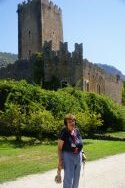 We stopped at the ruins of a medieval village, which once housed 5000 people and had 14 churches. Only the palace (with a huge tower; our guide said the higher the tower, the more powerful you were thought to be) and the town hall (restored as a summer home for the family that bought it) were in reasonable shape. It’s called Ninfa, in honor of the nymphs who supposedly inhabited the lake. The village is now kind of a nature preserve, with 14 full-time gardeners, and 25% of the property set aside for animals. We saw trees from all over the world, many of which have adapted well to the local climate. Incidentally, the area also grows 30% of the world’s kiwis, a plant we mistook for grape vines.
We stopped at the ruins of a medieval village, which once housed 5000 people and had 14 churches. Only the palace (with a huge tower; our guide said the higher the tower, the more powerful you were thought to be) and the town hall (restored as a summer home for the family that bought it) were in reasonable shape. It’s called Ninfa, in honor of the nymphs who supposedly inhabited the lake. The village is now kind of a nature preserve, with 14 full-time gardeners, and 25% of the property set aside for animals. We saw trees from all over the world, many of which have adapted well to the local climate. Incidentally, the area also grows 30% of the world’s kiwis, a plant we mistook for grape vines.
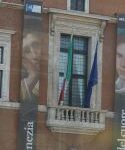
 And then there was the grand entrance to Rome, past the arch of Constantine (it was in the battle for Rome that he saw the image of Christ and, at least in the telling, that image led to victory, his conversion to Christianity, and the rest is a different chapter in Rome’s history); the immense neo-classic building of the 1870s celebrating the emergence of the
And then there was the grand entrance to Rome, past the arch of Constantine (it was in the battle for Rome that he saw the image of Christ and, at least in the telling, that image led to victory, his conversion to Christianity, and the rest is a different chapter in Rome’s history); the immense neo-classic building of the 1870s celebrating the emergence of the 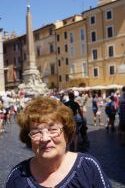
 Italian state; the balcony where il Duce mobilized Italian fascists in the 1930s; the Coliseum; the Forum (where the Republic extended the Greek concept of democracy); and the obelisks brought to celebrate the expansion of Empire. Rome should have a 900-page Lonely Planet, too. And a peek across the Tiber River revealed the dome of St. Peters and the Vatican City. And that was just on the way in!
Italian state; the balcony where il Duce mobilized Italian fascists in the 1930s; the Coliseum; the Forum (where the Republic extended the Greek concept of democracy); and the obelisks brought to celebrate the expansion of Empire. Rome should have a 900-page Lonely Planet, too. And a peek across the Tiber River revealed the dome of St. Peters and the Vatican City. And that was just on the way in!
We’ve been here once before, so I tried to see different things. Our hotel is near the ancient walls—and the Borghese park. The museum in the park is listed as “the one art museum” to see, and I’m off in an hour or so to pick up my reserved tickets (Rome has 4 million people and I think 8 million tourists).
It was really spectacular, both the contents and the building. Cardinal 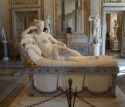
 Borghese was the secretary of state for the Papal States (appointed by his uncle, the pope), and used both his money and his power to collect art reflecting the greatness of imperial Rome and its Greek predecessor—and his own times. The power helped; part of his collection came when he threatened its previous owner with jail if he didn’t sell. Fortunately, he liked a lot of the same artists I do: there was a Caravaggio room, paintings by Raphael and Titian, and sculptures by Bernini. The museum was so popular that I had to get reservations yesterday, and had only two hours in the museum. I got there at 8:30, lined up to get my ticket, then lined up for the “rush” at 9 a.m. At 10:50, the loudspeaker announced that we were to leave and make way for the next group.
Borghese was the secretary of state for the Papal States (appointed by his uncle, the pope), and used both his money and his power to collect art reflecting the greatness of imperial Rome and its Greek predecessor—and his own times. The power helped; part of his collection came when he threatened its previous owner with jail if he didn’t sell. Fortunately, he liked a lot of the same artists I do: there was a Caravaggio room, paintings by Raphael and Titian, and sculptures by Bernini. The museum was so popular that I had to get reservations yesterday, and had only two hours in the museum. I got there at 8:30, lined up to get my ticket, then lined up for the “rush” at 9 a.m. At 10:50, the loudspeaker announced that we were to leave and make way for the next group.
The grounds constitute the biggest public park in Rome, and I went back later to another museum, dedicated to a late 19th-early 20th century sculptor who had aristocratic clients. One client was Atatürk, and the artist’s renditions of the great leader of Turkey are in Ankara. Another was Grand Duke Nicholas, whose statues were delivered to St. Petersburg in 1914, but did not survive the Russian Revolution.
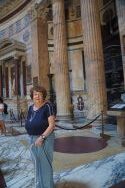 Carolyn’s target was the Pantheon, built originally by Hadrian in 120 AD. It was the largest dome in the world until the 16th century, and remains the largest unsupported concrete dome today. Once dedicated to all gods, it became a church in 608 AD and it still is. The 16 Corinthian columns in front are striking—and so were the armed guards, but this is Europe.
Carolyn’s target was the Pantheon, built originally by Hadrian in 120 AD. It was the largest dome in the world until the 16th century, and remains the largest unsupported concrete dome today. Once dedicated to all gods, it became a church in 608 AD and it still is. The 16 Corinthian columns in front are striking—and so were the armed guards, but this is Europe.
We spent the rest of the afternoon on the on-off bus, mostly on, seeing what we could in the one day we were in Rome.
Otherwise, our day would have been totally ruined.